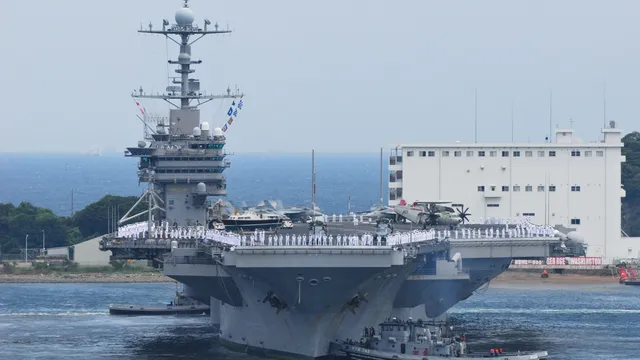
US pilots conduct landing drills on Iwo Jima amid regional tensions
2025-05-27 11:58- The USS George Washington resumed forward deployment in Japan after a lengthy refurbishment and is currently the only forward-deployed carrier in the region.
- US Navy pilots are conducting landing drills on Iwo Jima, a military significance site for training since 1989, to enhance proficiency and readiness.
- The exercises aim to strengthen deterrent capabilities against regional threats, particularly from China's growing naval forces.
Express your sentiment!
Insights
The United States Navy is currently conducting field carrier landing practice on Iwo Jima, a critical military training site, involving naval aviators from the USS George Washington. This training is intended to prepare these pilots for deployment and enhance their operational readiness. The USS George Washington is the only forward-deployed aircraft carrier in Japan, having arrived at Yokosuka Naval Base on November 22, 2024, following an extensive and delayed refit. Historical context reveals that this carrier was previously deployed to Japan between 2008 and 2015, during which time the regional military landscape has changed considerably due to China's rising naval capabilities. With the People's Liberation Army Navy's (PLAN) expansion, including the introduction of its first aircraft carrier and the development of a drone mothership, the strategic environment has become increasingly tenuous for US interests in the Indo-Pacific region. The field carrier landing practice being conducted is vital not only for the preparation of US forces but also serves as a deterrent to potential aggression from China. Japan's Ministry of Defense highlighted the importance of this training for enhancing defense cooperation and strengthening regional response capabilities. Historically, the US Navy has utilized Iwo Jima for carrier landing practice since 1989, reflecting its strategic significance as a location for such military operations. The ongoing drills will continue through the end of May 2025, indicating a sustained commitment by the US to maintain its military readiness in an area shaped by rapidly evolving threats. The training exercises not only aim to improve skills but also underscore the importance of US-Japan military collaboration in the face of emerging challenges. As the US has not announced details regarding the potential future deployment of USS George Washington, its operations in Japan remain a focal point for regional security initiatives amid shifting geopolitical dynamics. This emphasizes the necessity of US military presence and readiness in the Indo-Pacific, as tensions with China continue to escalate and new military technology developments take shape.
Contexts
The ongoing expansion of China's naval capabilities has significant implications for United States military strategy, particularly in the Asia-Pacific region. As China invests heavily in modernizing its naval fleet, including the development of aircraft carriers, submarines, and advanced missile systems, the balance of power in regional waters is shifting. This expansion not only enhances China's ability to project power beyond its shores but also poses challenges to U.S. maritime dominance. The U.S. Navy, which has traditionally operated with relative freedom in these waters, may find its operational space increasingly constrained as China's naval presence expands and assertiveness grows, particularly in contested areas such as the South China Sea and around Taiwan. In response to China's naval expansion, the United States has been compelled to reassess and adapt its military strategy. The U.S. must focus on bolstering its presence in the region through increased naval deployments, enhanced alliances with key partners in the Asia-Pacific, and investment in advanced maritime technologies. Initiatives such as the Quad alliance—which includes the U.S., Japan, India, and Australia—emphasize collaborative security efforts to counterbalance China’s growing influence. Furthermore, the U.S. may need to develop innovative operational strategies, including asymmetric capabilities that leverage technology, cyber warfare, and unmanned systems to maintain a competitive edge. Additionally, the naval expansion has intensified the need for strategic deterrence. The United States must ensure that its forces are capable of deterring potential aggression by demonstrating a credible commitment to defend its allies and maintain freedom of navigation. The potential for conflict in areas where U.S. interests intersect with Chinese territorial claims necessitates a reassessment of existing defense postures and an emphasis on joint exercises to fortify military readiness. Investing in missile defense systems and enhancing undersea capabilities are also critical components of this deterrence strategy, especially in light of China’s rapid development of anti-access/area denial (A2/AD) systems. Ultimately, the impact of China's naval expansion is profound and multifaceted, influencing not only U.S. military strategy but also the broader geopolitical landscape. As China continues to assert its maritime ambitions, the U.S. must adopt a flexible and proactive approach to adapt to evolving threats. The future will require a combination of diplomatic engagement, military preparedness, and strategic partnerships to navigate this increasingly complex security environment. The trajectory of U.S.-China relations will largely hinge upon how effectively the U.S. can balance deterrence with the necessity for constructive dialogue, ensuring regional stability in the face of growing maritime competition.